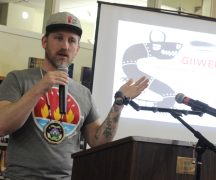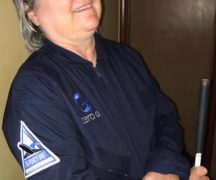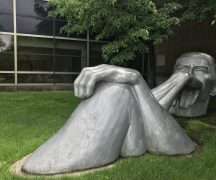By DAVID DUPONT
BG Independent News
It’s safe to say that most sighted folks are in the dark about what it is to be blind. Sheri Wells-Jensen, a linguist, musician, and avocational scientist who happens to be blind, set about proving that recently at an Institute for Culture and Society lecture at Bowling Green State University.
The talk was being presented in the planetarium – appropriate given it dealt with extraterrestrial life. Jensen had all the lights shut off. She let her listeners sit there. In near total darkness. She quizzed them on how they felt, how uneasy they felt.
“This is not blindness,” Wells-Jensen said. “This is you not seeing when you expect to be able to see. This is your reaction to darkness. Totally blind people don’t see blackness. Blackness is a color. Blackness is something you see. … It’s mediated by culture, by all those things that go bump in the night.
“What do you see out of the back of you left hand? That’s blindness.”
That is not helplessness, a perception Wells-Jensen struggles with constantly.
Growing up she was passionate about physics and astronomy. But in those days that was not something a “blind girl” was expected to be able to do. She became a linguist, but never lost her fascination with the stars.
Among her many areas of expertise is xenolinguistics, the study of alien languages. So she was thrilled when she was invited to speak at a SETI (search for extraterrestrial intelligence) Institute. The talk on linguistics went well. Then with the question and answer session over, she turned to leave the podium, only to have someone immediately approach to assist her, as if she wasn’t capable.
Now sighted people should they be struck blind would not be able to navigate to find their way home, and she said they do give horrible directions. “You lack about 90 percent of the skills you need. Many of you could acquire the skills to do that, but right now you don’t have those skills.”
She can get around town, and around the globe.
Wells-Jensen imagined, and asked her audience at the lecture to imagine, an alien species who do not have the sense of sight, named the Krikkits for creatures in Douglas Adams’ “Hitchhiker’s Guide to the Galaxy,” “only much nicer.”
“Imagine a species comfortable in this natural state, comfortable in what you see in the back of your left hand,” Wells-Jensen said. “Imagine a species where the local language lacks a word for blindness because it lacks a word for sightedness.”
It would be a civilization with all the capabilities to work, play, raise families, and do science. A civilization able to reach out to seek life beyond their solar system.
Wells-Jensen noted that it is expected some form of at least primitive extraterrestrial life, at the microbe level, will be discovered within 20 to 30 years.
Dale Smith, the planetarium director, briefly explained where one may find life similar to what we’d recognize as life. Each solar system may have a narrow band, room for at most three planets with the conditions that could have liquid.
Wells-Jensen’s aim was to take her Krikkits from Stone Age technology to being sophisticated enough to make a radio telescope. This was more than a thought experiment. Wells-Jensen went out into her yard, determined to outline the shadows cast by the sun, or out at night to ponder the stars. She tried not to get discouraged or sad at failures. She went online to see what other innovators who were blind had created. Since her family would not let her build a smelter for metal in the back yard, she had to find analogous activities.
She suggested to her colleague Joel O’Dorisio, in the School of Art, that she could blow glass. She expected to meet resistance. Instead he immediately invited her into the glassworks. This convinced her that creating metal would not be a problem.
“Anything that’s a tool is a sensing device,” she noted. Just think about using tongs to get a potato from a pot of boiling water.
Wells-Jensen took her civilization up through food production – they’re vegetarians – through navigating by using radar. That’s how they would discover the moon – a big rock in the sky, the sun, and the stars. Then they might consider trying to see what else might be living out among those stars.
The problem, though, may be if they contacted another species, they’d best not expect these other alien beings to be able to give them good directions.





